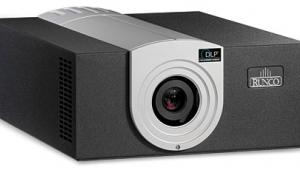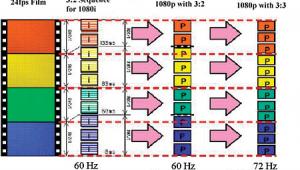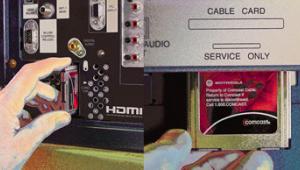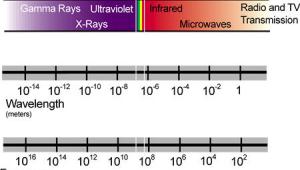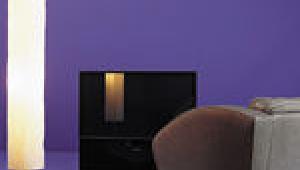Viewing Distance vs. Resolution

Resolution starts (and ends) with the eye. If you're one of the lucky few with 20/20 vision (corrected or not), your eye can discern one-sixtieth of a degree of arc at 20 feet. Translated to inches, this means that, at 20 feet, your eye can discern objects roughly 0.067 inches wide, as long as there's enough of a contrast difference between the object and the background. This refers only to black-and-white info; your eye doesn't resolve color nearly as well as black-and-white. Also, eyes and contrast are a whole other GearWorks that I'll get to eventually. Lastly, we're going to stick with width for simplicity, although this discussion obviously applies to both width and height. Most people sit about 10 feet from their TVs. At this distance (and everything else being equal), your eye can resolve objects that are 0.033 inches wide.
Talk TV, Smart Guy
The average 42-inch-diagonal, 1,280-by-720 plasma or LCD display has pixels that are roughly 0.029 inches wide. (Of course, each model has different inter-pixel spacing, but, for now, we'll assume they don't.) If the same size display had a resolution of 1,920 by 1,080, the pixels would be 0.019 inches wide. As you can see, in a 42-inch display at a distance of 10 feet, your eye can't discern the resolution available even with 720p. Even more resolution is "wasted" at 1,920 by 1,080.
Now, assuming that you're not going to move your couch but you want a bigger TV, how does this work with a 50-inch set? The pixels in a 1,280-by-720 display are 0.034 inches wide, which is almost exactly what your eye can discern at 10 feet. A 1,920-by-1,080 display has 0.023-inch-wide pixels, smaller than your eye can resolve. A 1,920-by-1,080 display would have to measure more than 70 inches diagonally before you start testing your eyes' limits on the display's resolution (at least at 10 feet). Scan lines are the pixels of the CRT world and, in this case, function similarly. The pixels in some displays are not square, in which case you'll also need to check pixel height.
Hold Up, Math Whiz
That isn't the whole story. High resolution, in and of itself, isn't why the the move was made to HD. Ideally, a screen should fill 30 degrees of your field of view for so-called "optimum viewer enjoyment." This is why kids sit so close to the TV, and movies in the theater were more fun than your old TV. By making the screens wider and letting you sit closer (thanks to the higher resolution), the average TV's field of view went from 11 degrees (in most cases) with NTSC to 33 degrees with an ideal HDTV.
Rarely is everything ideal, though. The "3x picture height" rule that's tossed about as the ideal seating distance for HDTV (compared with 7x for NTSC) doesn't take into account that displays and high-definition material aren't perfect (and, until recently, none were really 1,920 by 1,080). Just because you can match or exceed your eye/pixel resolution doesn't mean that the material you're watching has anything close to that level of detail. Video noise, artifacts, and poor-quality low-resolution sources (NTSC cable/satellite feeds) are all too noticeable at close distances.
To split the difference between NTSC and HDTV, I recommend a 5x seating distance as a starting point (even at a loss of field of view). At 5x, your eye can almost exactly resolve 720p, regardless of screen size. Since the original writing, we put this math to the test, with intersting results. You can read that article here.
So, Can I Buy a Cheap TV?
Just because your eye can't resolve the additional resolution doesn't mean that you shouldn't get a higher-resolution set; it just means that you don't necessarily have to. From where most people sit, you don't need 1080p in a 37-42 inch TV. It's arguable that you do in a 50-inch set. The key, then, is moving your seating. If you're sitting more than 5x the picture height away from your TV, then you probably don't need 1080p. If you can move closer, you should get the highest resolution display you can, sit close enough that you can't see the pixels, and enjoy your huge screen.
The Math
(Screen Diagonal x 0.87) / Horizontal Resolution = Pixel Width
(Screen Diagonal x 0.49) / Vertical Resolution = Pixel Height
At a distance of 10 feet, the eye can resolve 1/120 of a degree
of arc, which translates to a width of 0.033 inches.
- Log in or register to post comments






